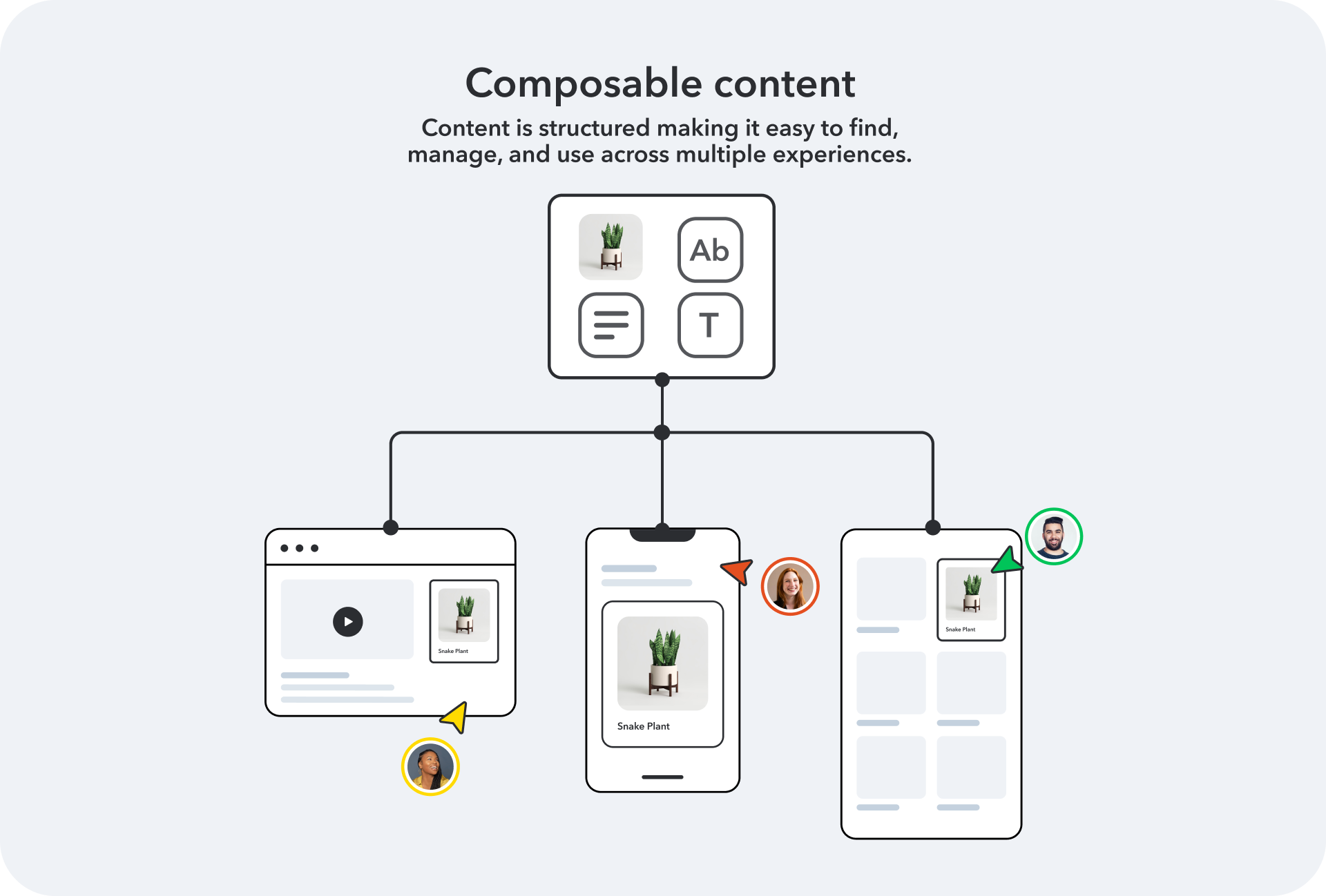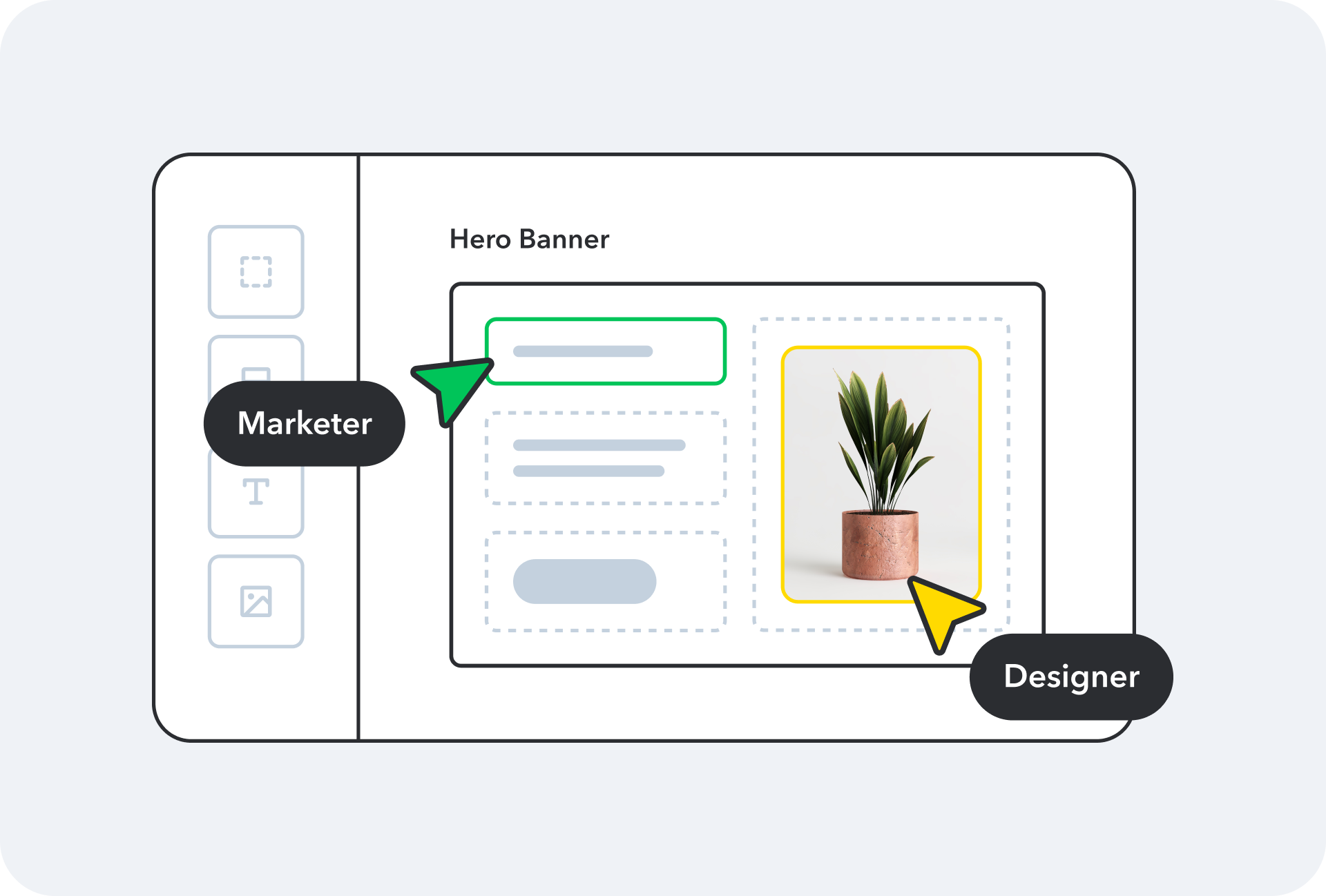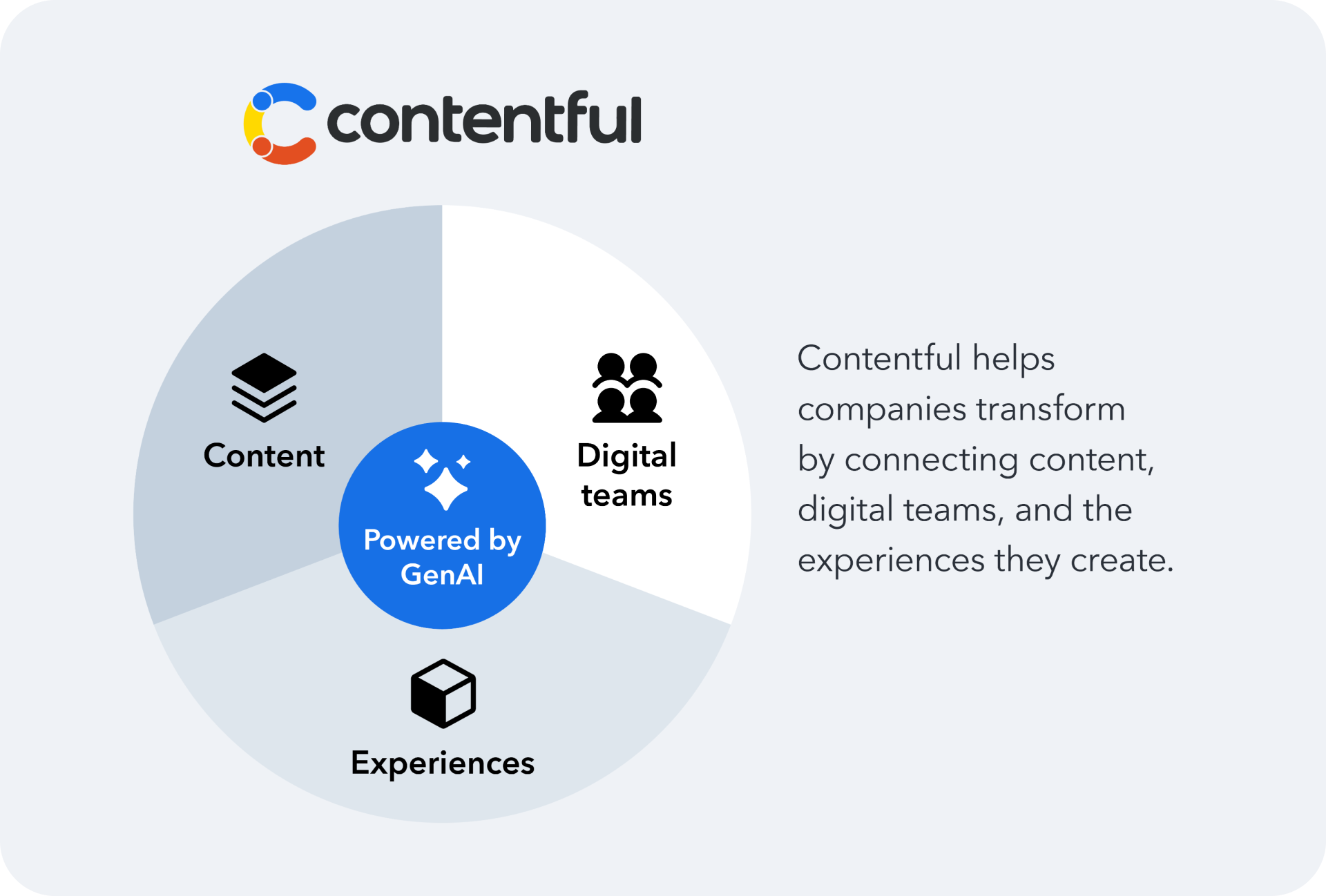
The Composable Content guide
What is Composable content?


Nicole France, Lisa Lozeau
Updated: November 21, 2024

The Composable Content guide
- 1. What is Composable content?
- 2. What is composable architecture?
- 3. Composable vs headless
- 4. What is a composable CMS?
- 5. From composable content to composable commerce
- 6. Composable content for marketers
- 7. Composable content for developers
- 8. How composable content is transforming digital experiences across industries
In this guide we’ll cover everything you need to know about what composable content is, how it helps companies deliver the experiences customers expect, and how you can get started with a composable approach.
Composable content
Composable content is a means of orchestrating and structuring digital content from any system. It organizes text, images, graphics, sound, and even data into small (but still meaningful) pieces that teams can use in any number of combinations across multi-brands, use cases, channels, and regions.

Composable content defined
Composable content is both the output and the process of orchestrating and structuring digital content from any system, allowing teams to quickly shape dynamic experiences for distinct audiences. You can think of composable content as the door to limitless configurable content.
What sets composable content apart is that content creators, developers, and machines can all easily interact with it. It’s API-accessible so everyone who needs to can work with and use it — quite different from the content stored in legacy content management systems.
Composable content also leans heavily on structured content — segmenting text, images, graphics, sound, and even data into small (but still meaningful) pieces so that they can be readily used in any number of combinations in any context, channel, or device. It’s pure content that can be used anywhere with any language presentation layer.
Composable enables a new way of working with content at scale
In the last decade, we've seen the market transition from channel-first digital marketing to experience-first marketing that focuses on the customer journey as a whole, not as a series of websites, apps, emails, and advertisements. Connecting all these pieces into cohesive experiences requires companies to think and work differently. It requires new technologies that support a composable approach and composable content.
In the old way of working, first you picked a channel and then you created the content. So, maybe you created a web page in a content management system. Then, you needed content for the mobile app, so you created that in another system. But then you needed an email too, so you copy/pasted content into another system. And if it was for a global campaign, you repeated the process for each additional market, translating content manually along the way.
A more efficient content creation process for any digital channel
With a composable approach, you might start with a specific channel in mind, but you're also mindful of the other channels your customers will use to experience that content. This changes the content creation process: you worry less about how the content will be presented, and instead focus on producing high-quality, engaging content. The goal is to create great content once and reuse it everywhere.
Instead of creating content in a big block, you fill out a series of smaller chunks that have been defined by your developer and information architect. Why? Because this enables developers to take your content and quickly integrate it into the front end. It also means you and other editors can mix and match content to compose different experiences instead of recreating it for each channel.

For example, having two chunks or content types called "product benefits" and "usage instructions" makes it easy to pull this content into a product page and combine it with content from an ecommerce platform. You can also quickly apply different visual styles to copy elements. If all that content was stored in the same field, it'd be extremely hard to reuse it in these different ways.
Employing a composable content method makes working with content more efficient. That means you can spend time on more interesting things — like localization and personalization.
Curious about how composable content works? Watch this demo to learn how a composable content platform makes it easier to maintain and deploy content across different channels and geographies that need localized content and a consistent brand message.
Why digital leaders are adopting a composable content strategy
Companies are racing to build and launch better experiences faster, but the teams building these experiences are slowed down by disconnected tools, rigid templates, and unnecessary dependencies between developers and marketers. Trading monolithic tools for a composable ecosystem is less about the technology and more about the digital transformation it enables.
A composable content strategy changes how teams work and the digital experiences they can deliver.
Composability helps teams build more efficiently
Gavin Estey, VP of Technologies in America at Appnovation, says the power of composability lies in its ability to help teams “do things better than they did before — be that creating content and sharing content at speed or driving velocity and internal efficiencies.”
Composable ecosystems combine the best tools into an intuitive user interface
Kelly Goetsch, Chief Strategy Officer at commercetools explains that the cloud changed everything, ushering in an era of purpose-built microservices. Shifting from a monolith to a composable tech stack means you can choose the best tools for every business function, such as ecommerce, content, omnichannel, advertising … whatever areas your business wants to optimize.
Composable content lets you appeal to customer emotion
Casper Rasmussen, Group SVP of Technology at Valtech, and president of the MACH Alliance, says that content is the key to injecting emotion. It takes flat copy and helps you connect with where each customer is on their journey. That sounds ambitious, but composable content makes your content modular and customizable. It makes omnichannel and personalization possible at scale. “If you can look at composability from a customer's journey perspective, you’re able to reuse your content in multiple different permutations and manifestations,” Rasmussen pointed out. “There’s more opportunity to inject emotion — the essence of your brand, its story, and authenticity.”
What are the benefits of a composable content platform?
Composable content platforms give you all the perks of a headless CMS with more flexibility and extensibility. Composable content platforms enable teams to draw content from many parts of the business and combine it in intelligent ways. They structure content and empower teams to build experiences customers will love from the building blocks they’ve already created.
A composable content platform is the technology that powers your composable content strategy, connecting content to all of the other tools teams use to create compelling digital experiences.
Six reasons brands love composable content
- It unifies your content across environments (and CMSes) so everyone has access to what they need.
- It drives brand loyalty with consistent messaging and visual identity.
- Teams are empowered to quickly design and roll out relevant experiences.
- They can connect with customers on a deeper level by layering in new capabilities like personalization and localization.
- It’s easier to take advantage of AI integrations with APIs and structured content.
- Creative and technical teams experience greater productivity and more efficient content operations.
Check out our Marketer's Guide to Composable Content to see how composable strategy helps marketers improve digital content management and publish content faster.
Discover how Heap uses composable content to deliver data-informed digital experiences at scale
Heap delivers business-critical insights and analytics to its customers, empowering them to identify winning content and areas for improvement.
When it came to redesigning its marketing website, Heap wanted a platform that would enable the company to drink its own champagne. By utilizing its own tools to track and analyze site data, the company would be able to quickly determine which content and elements to optimize to enhance customer experience. Heap, however, faced digital roadblocks attempting to achieve this with their legacy system.
“We get data from Heap, but it’s useless unless you can act on it,” said Ben Lempert, Director of Web and Content at Heap. “Contentful lets us take action and quickly modify the experience we’ve created to satisfy user needs based on their behavior. This combination is really a supertool for delivering customers the value they’re looking for.”
Learn how Heap was able to transition their entire 600-page website in just three weeks with Contentful, leading to better alignment with user needs and expectations.
See more inspiring case studies about the impact of composable across industries in the last chapter of this guide.
Key principles of composable content
A composable approach to the content creation process consists of a set of principles, processes, and tools that enable teams to work autonomously, while maximizing the value of content across the organization.
 |  |  |
 |  |  |
What to consider when you’re evaluating a composable content platform
Just as everybody was quick to jump on the headless CMS bandwagon, everybody wants to offer composable business capabilities. Understanding what composable content is (and isn’t) is critical when choosing a composable content platform.
-
It’s separate from the presentation layer. In other words, if you have to copy and paste content from one format to another, it’s not composable content. Modern digital experiences are multi-channel. Composable content enables content creators to create content once and use it over and over in any channels they choose.
-
It’s pulled from multiple sources via APIs. Again, if you’re copying and pasting content, it’s not composable. Composable content is programmatically accessible in a predictable, universal format (like JSON or GraphQL). Creators can pull content from multiple sources, and stitch it together into new experiences without introducing inconsistencies.
-
Developers and editors can use it. This is a critical test of whether your content is truly composable. Developers can mimic composable content by pulling content from multiple sources together into a new experience via code. But this isn’t scalable. Instead of creating frustrating dependencies between editors and developers, composable content empowers editors to easily manage this content and put it together whichever way they want, without the help of developers.
-
Content is easily discoverable and orchestrated across your digital portfolio. If you have hundreds of digital properties across different brands and markets, the content, apps, and templates you create should be accessible from one environment to another. This shouldn’t just be theoretically possible. Applying metadata to structured content makes it easy to surface the right content to users.
Adopt a future-proof composable content approach with Contentful
Nearly a decade ago, Contentful pioneered headless CMS, a cutting-edge technology that propelled our customers into the future. We’re leading the way again with the Contentful Composable Content Platform designed to help you deliver the next wave of digital experiences.

Why leading companies trust Contentful
Deliver value and a positive ROI sooner. Pre-built templates and integrations (even with legacy tools) get you started faster.
Add capabilities as you scale with a pluggable ecosystem of tools.
Maximize efficiency and unlock creativity with generative AI integrations.
Continuously improve and optimize your strategy with flexible tooling and inspiring use cases.
Maintain brand integrity. Teams are empowered to build fresh digital experiences using consistent design and content elements.
Get closer to your customers. Create once and generate multiple variants for audiences, channels, or use cases.
Choose with confidence. Contentful powers innovative content experiences for thousands of organizations around the world ranging in size from small to enterprise-grade.
Learn how you can unlock the power of digital content with the Contentful Composable Content Platform.
Up next: What is composable architecture?
Learn about composable architecture, its differences from traditional approaches, how to implement it, and the key pillars for evaluating its value.
Written by

Nicole France
Nicole evangelizes new ways of thinking about content and the work of digital business. Her perspectives draw on past experience of both doer and thinker. At Contentful she gets to do both. As chief evangelist, she works with customers, partners, industry experts and the Contentful crew to envision the art of the possible and identify the practices that make it reality.

Lisa Lozeau
Lisa Lozeau is an expert in content strategy, content creation, and content marketing, where she has utilized these skills as a writer at Contentful for over 6 years. She has led marketing programs across several industries on a variety of platforms. Well-versed in the limitations of traditional CMSes, she is passionate about innovative solutions.








